Assignments - Admin Guide
- 1. SECTION 1: ASSIGNMENT SCHEDULER FEATURE - OVERVIEW
- 2. SECTION 2: HOW TO GUIDE: ASSIGNMENT SCHEDULER
SECTION 1: ASSIGNMENT SCHEDULER FEATURE - OVERVIEW
Who Should Use This Guide
This guide is for - Learning Management System (LMS) Client Super administrators (CSA) and Administrators to enable them to utilize and train others in the use of the Assignment Scheduler Functionality.
What is the Assignment Scheduler?
In the Learnsoft LMS, the Assignment Scheduler is a powerful feature and service that enables courses to be automatically assigned to individual or groups of users with a specified deadline based on Administrator defined criteria. These assignments can be one time or as recurring events.
Examples of assignments include:
- An Assignment can be scheduled to run daily that searches for new employees and then assigns a mandatory company or safety orientation class to all such new employees.
- An Assignment can run annually that ensures all employees take a compliance course each year.
- An Assignment can run one time that ensures all persons with a specific job position in all locations or specific locations of an organization are enrolled in a training course due within a defined timeframe.
The Assignment Scheduler combines an advanced feature that allows CSAs to schedule (create, modify and delete) assignments for individual or a group of students that fall within an Admin defined Scope (meet specific criteria that make them eligible for the assignment) with an external service that runs daily (usually nightly) to execute these assignments based on a defined deadline.
Because this is an advanced feature, the Assignment Scheduler Service is not always activated as part of the initial implementation of the LMS system, but is often activated and scheduled after the CSA and administrators become more familiar with the basic elements system
NOTE: Before assignments can be scheduled, you must ensure that the Assignment Scheduler Service has been activated and scheduled. This can only be completed by the Learnsoft Technical Team. Please contact your assigned Project Manager to enable the activation and scheduling of this service1.
.
Three Elements Required for Execution of Assignments
An assignment requires three elements to be successfully executed by the assignment scheduler. Below are brief descriptions of the required elements. For further details see, both the How To Guide (Section 2) and the Advanced Concepts Guide (Section 3).
- Scope This determines which users or group of users will receive an assignment.
- Deadline This determines both when the assignment is due and when the users will receive the assignment.
- Learning object This is usually the course(s) that are assigned (Options allow for selection of certifications or goals instead of courses)
Course Overview
The purpose of this manual is to guide administrator(s) on how to effectively create and schedule Assignments using the Assignment Scheduler service and functionality of the LMS system.
Once the Assignment Scheduler Service has been activated and scheduled, the CSA can create assignments by using the Assignment Scheduler Feature, which is accessible through the Advanced View > Learning Objects > Assignments drop down menu.
This course will cover the basic steps to creating an assignment including:
- Accessing the Assignment Schedule Feature
- Creating new assignments
- Filling in the Assignment Info Section
- Filling in the Assignment Timing Section
- Filling in the Selectors Section
- Filling in the Available / Excluded users Section
- Selecting, Editing and Deleting assignments
- The course will also provide details about some Advanced Concepts of the Assignment Scheduler
SECTION 2: HOW TO GUIDE: ASSIGNMENT SCHEDULER
How to Add an New Assignment to the LMS System
The Assignment Scheduler is a powerful feature and service that enables courses to be automatically assigned to students based on Administrator defined scope and deadline criteria. These assignments can be one time or as recurring events
The Assignment Scheduler can be accessed using the Advanced View > Learning Objects > Assignments drop down menu.
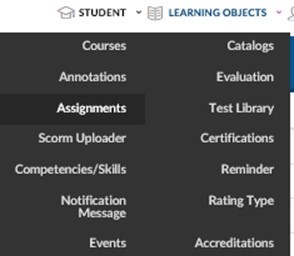
This will bring you to the Assignment List page where you can view, edit, delete existing assignments and create (and schedule) new assignments.

To create a new assignment:
- Click on the New Assignment button.
- This will launch the Learning Object >> Assignments / Assignment details page.
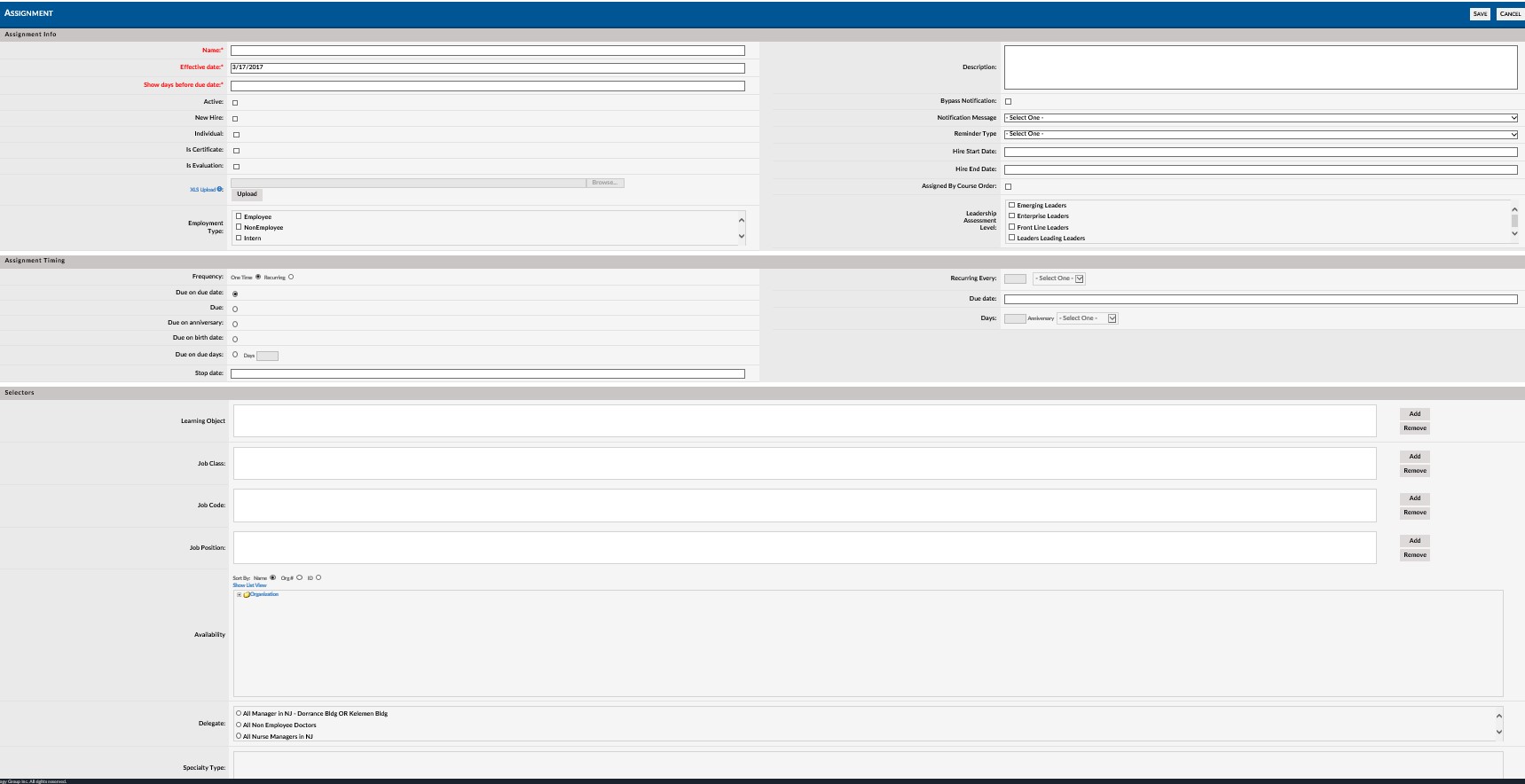
How to Fill-in the Assignment Info Section
The Assignment info section of the Assignments / Assignment Details page lets you name and describe the assignment, activate / deactivate the assignment, select the assignment type (course, certification, goal), determine if the assignment should be associated with specific individuals, new hires and/ or specific employment and leadership levels.

The only required entry in Assignment info section is a Name for the assignment.
By default, assignments will automatically associated between courses and groups of users that can be further detailed and refined in the Selector section of the Assignments / Assignment Details page, however, in this Assignment info section, this default can be overridden when enabling (checking) the optional checkboxes. This will also change the selectors available in the Selector section.
For example, if the Individual checkbox is enabled (checked), all the default options for selecting groups of users, such as job code or job class, will be hidden. If the Is Certificate checkbox is enabled (checked), the course selector will change to a certificate selector (See next section).
Below is a listing of each of the required and optional fields (attributes) of the Assignment info section along with a brief description.
Assignment Info Section - Explanation of Fields
- Name* - Creator defined name for the assignment.
- Active - If checked, it means it is ready to deploy and will be processed the next time the assignment scheduler service runs.
- New Hire - If checked, the system will apply this assignment only to newly hired employees.
- Note: The system uses a previously defined company timeframe which is added to the user’s actual hire date to determine if they are within Scope of an assignment.
- For example, if your company defines a New Hire within the system as 30 Days and a person is hired on January 1, 2016, then this person is within scope of this assignment from January 1, 2016 – January 31, 2016 (January 1, 2016 Hire Date + 30 days Defined Company Timeframe = January 31, 2016).
- Individual - If checked, allows the creator to assign individuals (rather than groups) to the assignment. When enabled it will change options in the Selectors section from group options (e.g. job class, job position) to a single / multi-student selector.
- Is certificate - If checked, allows the creator to assign certifications, rather than courses to in-scope students. When enabled, the Learning Object (Course) selector in the Selectors section will change to a Certificate Selector.
- Is Goal - Part of the Talent Management Suite (TMS). If checked, allows the creator to assign Goals to in-scope users.
- Is Evaluation - Part of the Talent Management Suite (TMS). If checked, allows the creator to assign Evaluations to in-scope users.
- Employment Type - Part of the Scope Process. Allows the creator to limit the assignment to users meeting a specific employment type or types from those predefined for your organization (e.g. Full Time Employees & Interns).
- If no selection is made, than any employment type is eligible to be in scope (subject to other scope restrictions made elsewhere in the assignment).
- Description - Allows for an assignment description (For Administrator Reference).
- Hire Start Date - Part of the Scope Process. Enter the Start Date for a range of dates. Anyone hired within that range of dates will be assigned.
- Hire End Date - Part of the Scope Process. Enter the End Date for a range of dates. Anyone hired within that range of dates will be assigned.
- Assigned by course order - New Feature. If checked, user must take courses in order they are added to the assignment.
- Thus if two courses were added, for example, "Beginner Excel" and "Intermediate Excel" (added to the assignment in this order), the assigned student must complete "Beginner Excel" prior to taking course â"Intermediate Excel".
- Leadership Assessment Level - A specific Leadership type or types from those predefined for your organization (e.g. Emerging Leaders, Enterprise Leaders) If no selection is made, than this is not part of the scope process.
How.====How to Fill-in the AssignmentSelectors Timing Section
Section====
AssignmentThe timingbasic concept of an assignment in the LMS is oneto associate some group of users (Scope) with some specific learning object (Requirement) in some specific time frame (Deadline). In the Selectors section of the Assignments / Assignment Details page, the creator is able to choose both the specific requirement (usually (a) Learning object / Course(s) or Certification(s)) & make many of the mostselectors powerful,to butdefine sometimesScope most(as complicatednoted featuresome elements that filter the scope, such as employment type, new hire etc. were found in the Assignment info section of the Assignments / Assignment Details page).
Note: This guide assumes the CSA / Admin is familiar with using the system to select a single or multiple courses or scope selectors such as Job Position or using the tree structure of the AssignmentAvailability module.tree to select sections of an organization. If not, please see related help sections for further details as to how to utilize those specific elements presented below.
Different Views of the Selectors Section
The specific selector categories that are available to choose from in the Assignment TimingSelectors section of the Assignments / Assignment Details page allowswill youadjust dependent upon items the Assignment info section of the Assignments / Assignment Details page.
In the DEFAULT VIEW, the Selectors section will allow the creator to specifyselect theLearning dateObject which/ anCourse(s) assignmentto isassign, due,as thewell dateas whendefine thescope assignmentby isselecting executedfrom Job Class, Job Code, Position, Availability, Delegate fields. Also, if enabled, scope can be further defined using Specialty Type, Credential Type and madeSub visible to the user and the frequency of assignment.
NOTE: ASSIGNMENTS WILL ALWAYS HAVE SOME TYPE OF DUE DATE ASSOCIATED WITH THEMStatus.

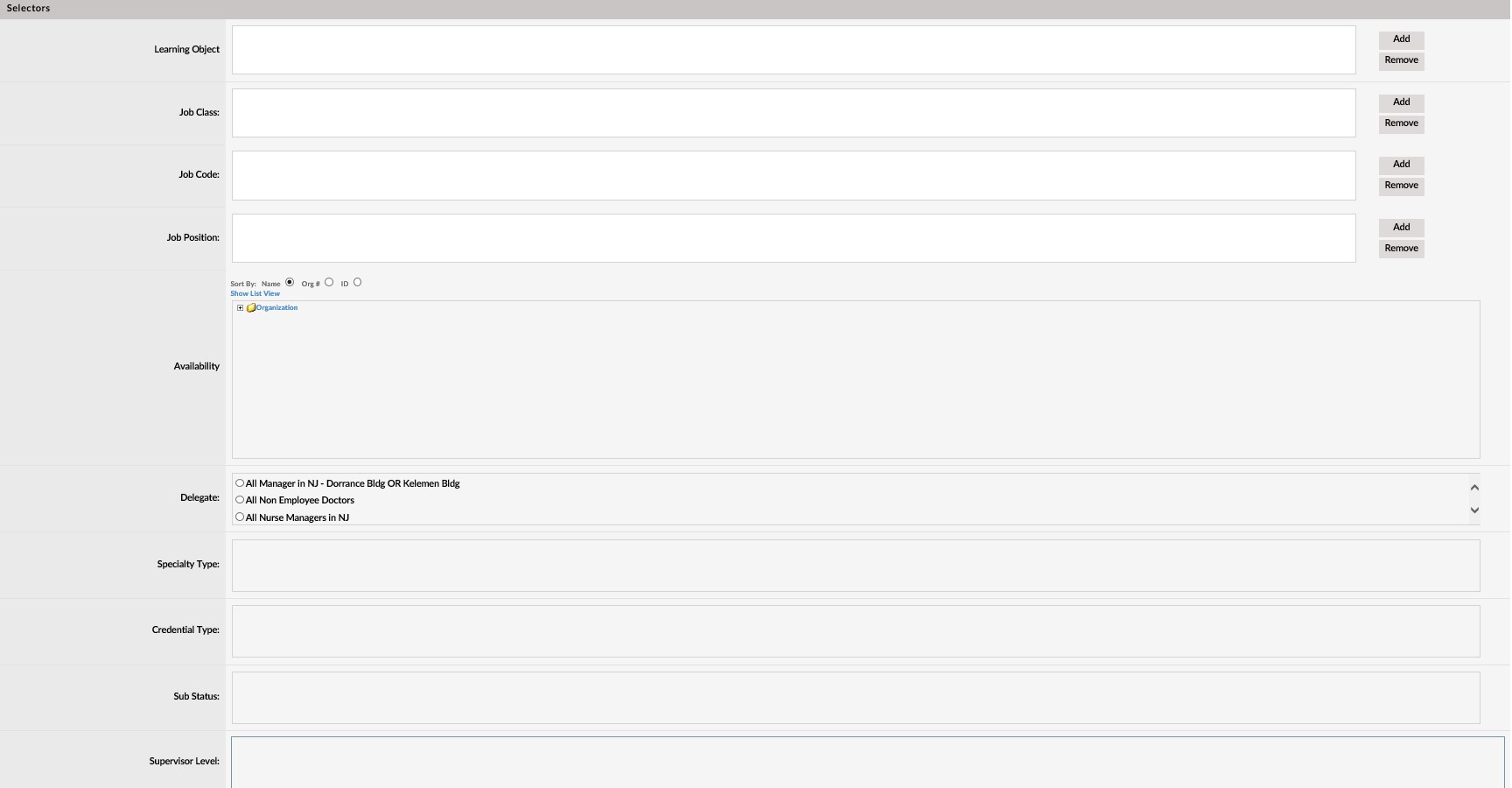
One-timeIf vs.certain Recurringoptions Assignments
Atare enabled (checked) in the basicAssignment level,info there are two typessection of timingthe frequencyAssignments for/ assignments:Assignment oneDetails timepage, however, the Selectors section will adjust and recurring.offer different selectors.
- For example, if the
OneIsTimeCertificateAssignmentscheckbox is enabled (checked), than the option to add Learning Object / Course(s) will not be shown.onceRatheratheuserCertificationfallstextwithinboxscopeandofbuttonsantoactiveAddone/timeRemoveassignment, theycertifications will beassignedvisible. Screenshot
Screenshotas7directed;Learninghowever,Objectthey>>canAssignmentsonly/fallAssignmentwithindetailsscopepage-once,Selectorsevensection - Certification ViewAnother example of a view change is if the
assignment“Individualâ€remainscheckboxactiveis enabled (checked), than the group selectors will no longer be visible andis executed daily byonly theassignmentLearningscheduler. - Object
For/example,Course(s)imagine an assignment that assigns the course "Basic Safety 101" to all users with the job class"manager". Also imagine that Bob R. Jones is an active employee, with the active job class designation "manager". Tonight, when the assignment scheduler executes this assignment, Bob R. Jonesselector will beenrolledavailable.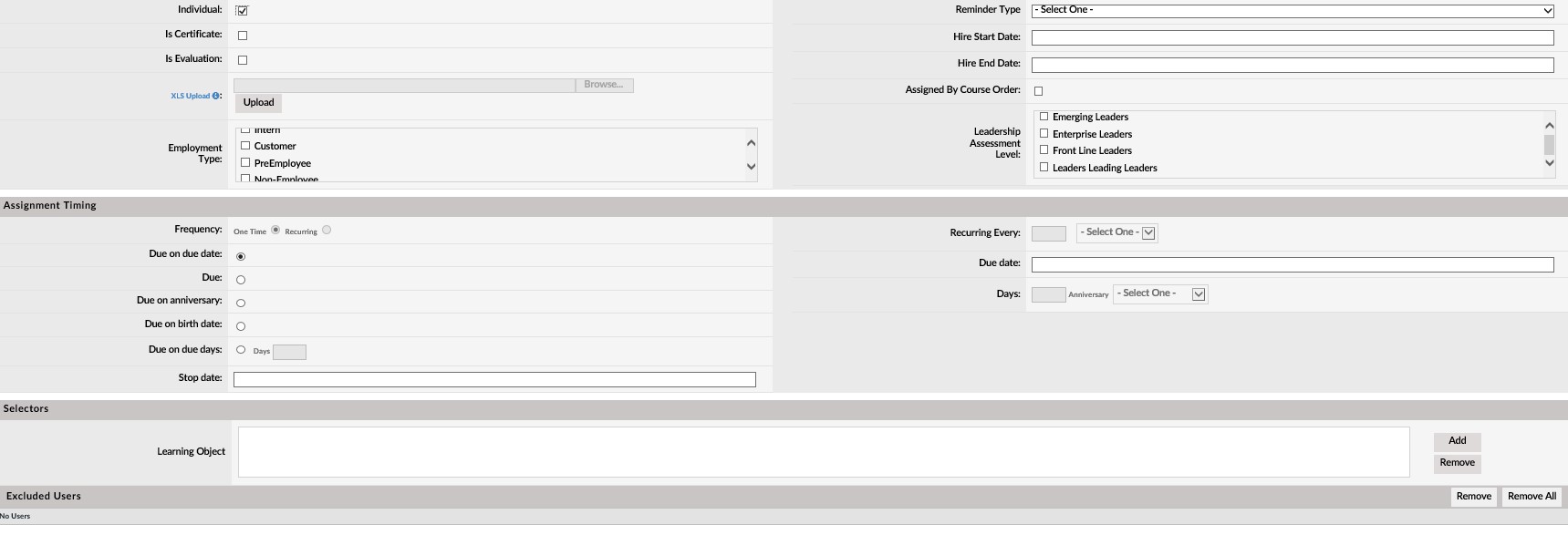 Screenshot
Screenshotin8Learning Object >> Assignments / Assignment details page - Selectors section -Individual View Adding Courses to the
"BasicAssignmentBy
Safety 101" course and Bob will receive an email notification ofdefault, theassignment. TomorrowLearning(andObjectso/onCourseuntil the assignment ends orselector ismadeviewable. Screenshot
Screenshotinactive),9Selectors whensectionthe-assignmentLearningschedulerObjectexecutes/again,Course(s)Bob R. Jones existing assignment will remain, but he will not again be assigned nor notified.
- By
Recurring Assignments- these are assignments that recur on some creator defined basis, for example onclicking theuser'sAddbirthday, onbutton, theuser'ssystemanniversary,willevery quarter, etc. During each recurrence, iflaunch theuserLearningremainsObject Lookup / Learning Object List inscope,atheynew popup window. Here, creators will beassignedablethetocourse. For example, imagine an "Annual Safety Compliance" course which is compulsorysearch andmustselect courses to assign. Courses can betakenaddedevery year based on the Anniversary of the user's hire date. If they were hired January 1, 2015, for example, then each successive January 1 (2016, 2017, 2018 etc.) they will be assigned this course (assuming the assignment remains active and they remain in scope).
Mandatory Timing Fields
Note: While an assignment may be due on a certain day or date, the assignment will executed by the Assignment Scheduler Service and made visible to the user, using a combination of scope and the mandatory fields: Effective date* and Show days before due date* and the elective Stop Date
''''''''''Effective DateEssentially the stat date for the assignment to be eligible for execution by the Assignment Scheduler Service (assuming it is made active).Stop Dateif not made inactive otherwise, this is the end date for the assignment.Note: If active, the assignment scheduler service will run this assignment every day from the start date until the stop date (if there is one; otherwise it won't stop as long as the assignment, assignment scheduler and LMS are active).Show days before due dateprovides the maximum lead time for which the assignment will executed and the user will be assigned and notified.For example, if an assignment is set to recur on a user’s anniversary date and show due date is set to 90, then (assuming effective and active) ninety days prior to the anniversary date, the assignment will be applied to the user.If a user becomes within scopeone at a timeframeorlessinthanmultiple selections (by using theshowcheckdaysbox)beforethenduepressingdate,the Add Learning Object button.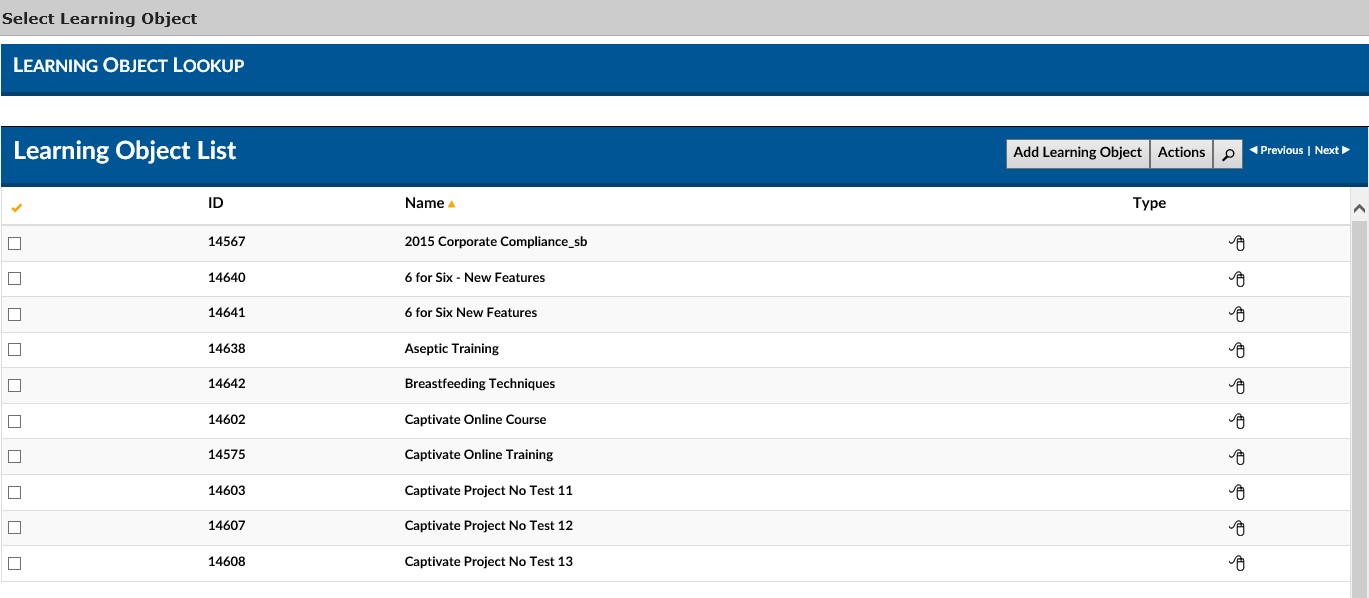 Screenshot 10
Screenshot 10Learning Object Lookup / Learning Object List Popup Window Once courses are added they will
be assigned as soon as becomingappear inscope.theForLearningexample,Objectbased/onCourse(s) selector textbox window. Screenshot 11
Screenshot 11Selectors section -Learning Object'/ Course(s) selector with course added They may be removed by first highlighting the
above,specific Learning Object / Course to remove and clicking the Remove button (While courses can be added in bulk, they must be removed individually).NOTE: See Section 3 - Advanced Concepts & Best Practices section for best practices using an Assignment Instance for courses which will allow users to select their own class instances if classroom-based courses are part of the
userassignment.Adding
becomesCertifications to the AssignmentIf the Is Certificate? Checkbox is checked, the system will replace the Learning Object / Course selector, with the Certification Selector.
Screenshot 12 - Selectors section – Certification selector with course added By clicking the Add button, the system will launch the Lookup / Certification List in
scopea30newdayspopuppriorwindow. Here, creators will be able totheirsearchanniversaryanddate,select Certifications to assign. Certifications can be added one at a time or in multiple selections (by using the check box) then pressing the Add Certification button.Screenshot 13 - Lookup / Certification List Popup Window Once certifications are added they will
receiveappear in theassignmentSelectorsatsectionthat–time
AssignmentScreenshot Timing Section14 - ExplanationSelectors ofsection Fields
– Certification selector with certifications added
They
Effectivemaydate*be-removed(REQUIRED)byAsfirstlong ashighlighting theassignmentspecificisCertificationactive,tothisremoveisand clicking thedateRemove button (While certifications can be added inwhichbulk,the Assignment will begin to be executed by the Assignment Scheduler service. It is essentially the assignment start date.Frequency- Radio button selector requiring either a value ofOne Time (default) orRecurring. Depending on selection, other elements of this section may or may not be accessible.Due on due date:- Radio button selector allowing creator to set a specific date by which the assignmentthey must becompletedremoved individually).
NOTE:
WorksSeeinSectionconjunction3with-DueAdvancedDate,Conceptsbelow. Note:&inactiveBest Practices section forRecurringbestassignments- practices
Due:using-anRadio“AssignmentbuttonInstanceâ€selectorforallowingcertificationscreatorwhich will allow users tosetselectatheirspecificownnumberclassof days before or after the Anniversary date by which the assignment must be completed. Works in conjunction with Days textbox and Anniversary dropdown box, below.Due on anniversary**- Radio button to indicate assignment must be completed by the user's anniversary date.Due on birth date:- Radio button to indicate assignment must be completed by the user's birthday.Due on due days:- Radio button selector allowing creator to set a specific number of days after a user comes into scope by which the assignment must be completed.Works in conjunction with Days textbox, below. Note: Not recommended for use with Recurring assignments.Days- Radio button selector allowing creator to set a specific number of days after a user comes into scope by which the assignment must be completedWorks in conjunction with Days textbox, below. Note: Not recommended for use with Recurring assignments.Stop date:- Date at which the assignment will stop and no longer run. User may use the dropdown calendar or enter the date manually using a mm/dd/yyyy formatShow days beforedue date*- The number of days prior to the due date in which the assignment will be effective and the user will be notified and enrolled in classes.For example,instances ifsetclassroom-basedtocourses30,arethe user will be notifiedpart of theassignment 30 days prior to the due date (assuming they were in scope and the assignment was active at least that many days before the due date).Due Date:- A specific date by which the assignment must be completedWorks in conjunction with Due on Due Date radio button, above. User may use the dropdown calendar or enter the date manually using a mm/dd/yyyy format. Note: inactive for Recurring assignmentsAnniversary**- Radio button to indicate assignment must be completed by the user's anniversary date.Note: inactive for one time assignmentsRecurring Every(text box) - Text box for numeric entry of a recurring period.Works in conjunction with the “Recurring Every†Dropdown box, below. For example, a biannual assignment would recur every 2 / years while a quarterly assignment would recur every 3 / months. Note: inactive for “one time†assignmentsRecurring Every(dropdown box) - Drop down box for selection of repeating period (Year, Month, Day).Works in conjunction with the Recurring Every text box, above. For example, a biannual assignment would recur every 2 / years while a quarterly assignment would recur every 3/ months. Note: inactive for one timeassignments
*Required Field
Anniversary In the LMS system, Anniversary refers to the anniversary of the user's hire date